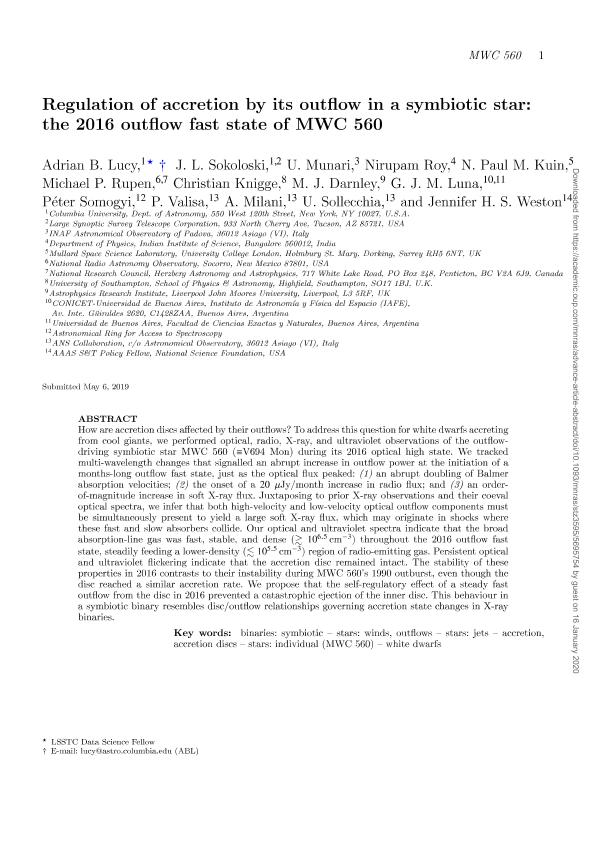Artículo
Regulation of accretion by its outflow in a symbiotic star: the 2016 outflow fast state of MWC 560
Lucy, Adrian B.; Sokoloski, J. L.; Munari, U.; Roy, Nirupam; Kuin, N. Paul M.; Rupen, Michael P.; Knigge, Christian; Darnley, M. J.; Luna, Gerardo Juan Manuel ; Somogyi, Péter; Valisa, P.; Milani, A.; Sollecchia, U.; Weston, Jennifer H. S.
; Somogyi, Péter; Valisa, P.; Milani, A.; Sollecchia, U.; Weston, Jennifer H. S.
 ; Somogyi, Péter; Valisa, P.; Milani, A.; Sollecchia, U.; Weston, Jennifer H. S.
; Somogyi, Péter; Valisa, P.; Milani, A.; Sollecchia, U.; Weston, Jennifer H. S.
Fecha de publicación:
03/2020
Editorial:
Wiley Blackwell Publishing, Inc
Revista:
Monthly Notices of the Royal Astronomical Society
ISSN:
0035-8711
Idioma:
Inglés
Tipo de recurso:
Artículo publicado
Clasificación temática:
Resumen
How are accretion discs affected by their outflows? To address this question for white dwarfs accreting from cool giants, we performed optical, radio, X-ray, and ultraviolet observations of the outflow-driving symbiotic star MWC 560 (≡V694 Mon) during its 2016 optical high state.We tracked multi-wavelength changes that signalled an abrupt increase in outflow power at the initiation of a months-long outflow fast state, just as the optical flux peaked: (1) an abrupt doubling of Balmer absorption velocities; (2) the onset of a 20 μJy per month increase in radio flux; and (3) an order-of-magnitude increase in soft X-ray flux. Juxtaposing to prior X-ray observations and their coeval optical spectra, we infer that both high-velocity and lowvelocity optical outflow components must be simultaneously present to yield a large soft X-ray flux, which may originate in shocks where these fast and slow absorbers collide. Our optical and ultraviolet spectra indicate that the broad absorption-line gas was fast, stable, and dense (≳106.5 cm-3) throughout the 2016 outflow fast state, steadily feeding a lower density (≲105.5 cm-3) region of radio-emitting gas. Persistent optical and ultraviolet flickering indicate that the accretion disc remained intact. The stability of these properties in 2016 contrasts to their instability during MWC 560's 1990 outburst, even though the disc reached a similar accretion rate.We propose that the self-regulatory effect of a steady fast outflow from the disc in 2016 prevented a catastrophic ejection of the inner disc. This behaviour in a symbiotic binary resembles disc/outflow relationships governing accretion state changes in X-ray binaries.
Archivos asociados
Licencia
Identificadores
Colecciones
Articulos(IAFE)
Articulos de INST.DE ASTRONOMIA Y FISICA DEL ESPACIO(I)
Articulos de INST.DE ASTRONOMIA Y FISICA DEL ESPACIO(I)
Citación
Lucy, Adrian B.; Sokoloski, J. L.; Munari, U.; Roy, Nirupam; Kuin, N. Paul M.; et al.; Regulation of accretion by its outflow in a symbiotic star: the 2016 outflow fast state of MWC 560; Wiley Blackwell Publishing, Inc; Monthly Notices of the Royal Astronomical Society; 3; 3-2020; 3107-3127
Compartir
Altmétricas



